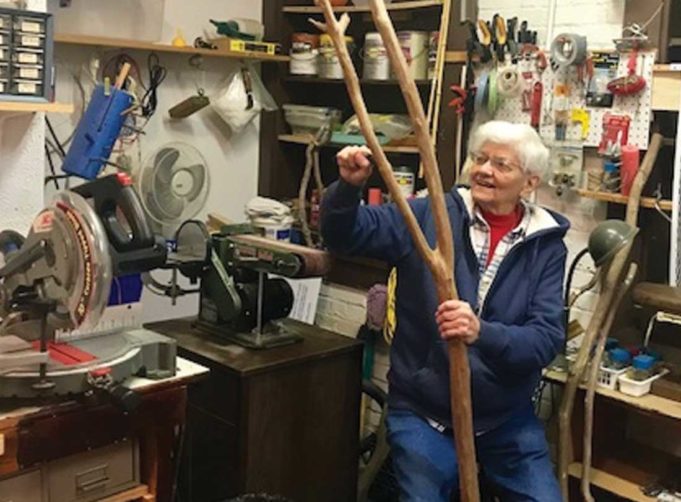Last year, while Stickman – a short film about a homeless Dallas man who found fame carving walking sticks – was showing on the indie film circuit, Camella Menotti was gathering limbs.
Menotti pruned the trees for years behind Our Lady of Victory Center, a two-story retirement home for Catholic nuns on the Near Southside before a cancer diagnosis and a torn rotator cuff. The 87-year-old planted about 50 of the center’s nearly 300 trees: pine, crepe myrtle, pecan, pear, apple, peach, and fig. She makes preserves from the fruit that the small band of sisters eats throughout the year. And now, she has some help looking after the center’s 13 acres.
“She’s the one with the whip,” joked David Gruver, 56, who began managing the grounds about three years ago. “I’d hate to show you my back. She’s taught me a lot about trimming the crepe myrtles and the fruit trees.”
Menotti said the crepe myrtle trees were so thick along a fence that she decided to start using the tree trimmings to create walking sticks. “I hated to throw those good sticks away,” she said lifting up a branch. “It’s beautiful wood.”
Rather than trashing the limbs, Menotti organized a workshop in the shed where she once ironed sheets as a young woman for the Catholic boarding school she attended next door. A peek inside the tidy shop reveals various tools, wood stains, and an assortment of walking sticks in the rough.
Last fall, thieves cut through a fence, broke into the building, and stole some of her tools and an air compressor. Since then, she’s had to reinforce the building’s entrance and buy a heavy padlock. “I think we’re good now,” she said.
Gruver said that since the shop has been ransacked twice, they had to install a security system. “They even stole my drinks, my Gatorades, and my peanut butter crackers,” he said. “That really made me mad.”
Now that things have returned to normal, when the weather is warm, Menotti, a former rodeo queen, is back whittling away at her walking sticks. She likes to call them staffs, which she says were symbols of leadership and often used to move cattle and sheep. She estimates that she’s made about 100 of them, which she sells or gives away to friends. While she’s experimented with pecan and elm, she said she prefers working with the crepe myrtle branches. Her all-time favorite creation was one she made that had a vine twisted around its center. She shared how she strips the bark off the crepe myrtle branches using a small knife.
“Sometimes, I’ll just go to town, if it’s a good sharp one,” she said.
When the bark is all removed, which sometimes requires a sander, she’ll smooth the whole branch down with sandpaper and then stain it with a red mahogany before sawing both ends off flat and adding a rubber tip. The work requires a steady hand, she said, and the whole process sometimes takes a week or more because the wood and stain have to be completely dry.
“In the summertime, she’ll have them all lying out there in the sun getting warm or leaning up against the building,” Gruver said.
A former pupil recently delivered about 100 sticks to Menotti, and she said she recently began training a young woman in the ways of walking-stick creation. A husband of one of the nurses at the center also built her a wooden stand for Menotti to be able to display her work inside the center’s lobby. While some handcrafted walking sticks sell for hundreds of dollars, Menotti said she can’t recall pricing any of her sticks at more than $45.
“That one’s strong,” said a visitor leaving the center about the thickest stick on display.
Occasionally, Menotti’s walking sticks can also be seen along the center’s hallway. That’s because she’s given several away to those who may need one while out for a stroll. She said while some of her friends tell her they “don’t need it,” others seem like to use the crooked ones.
“It’s therapy for me,” Menotti said of her walking stick-making hobby. “Every time I go to the cancer center, I take mine.”












